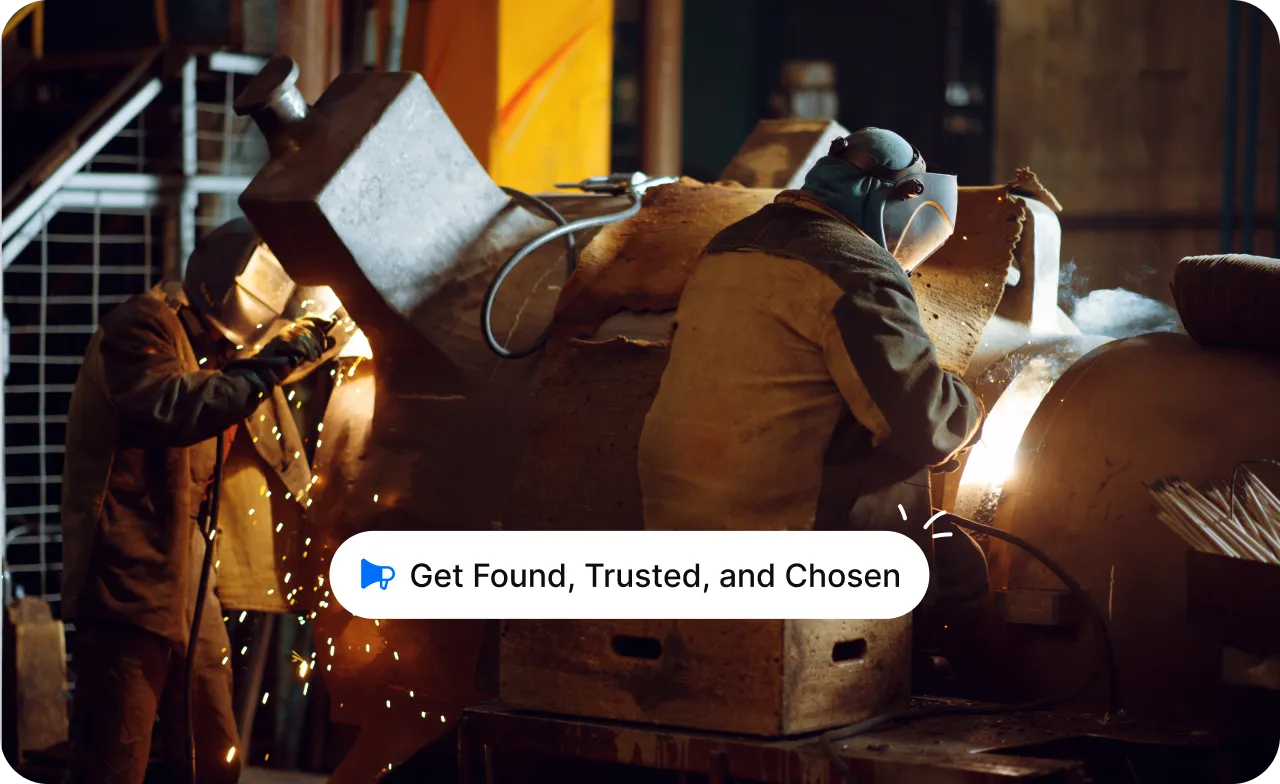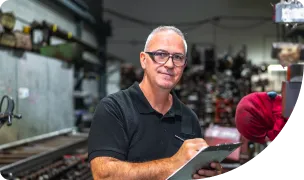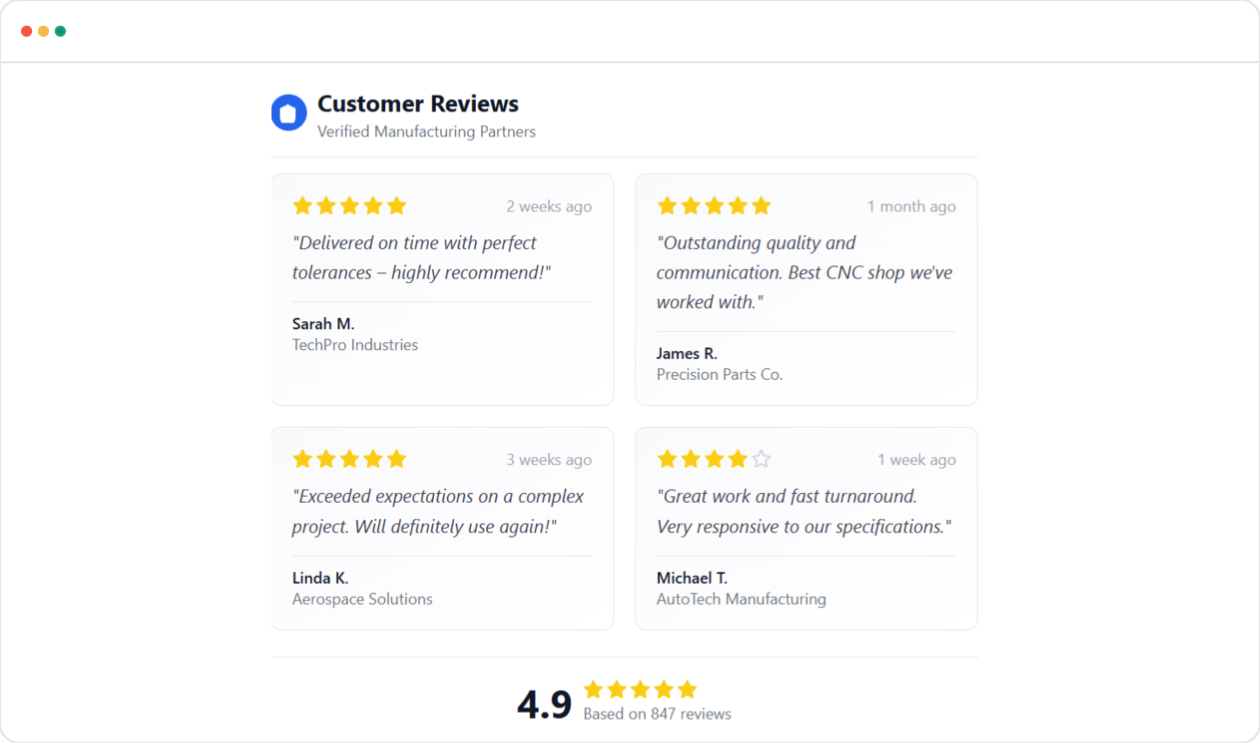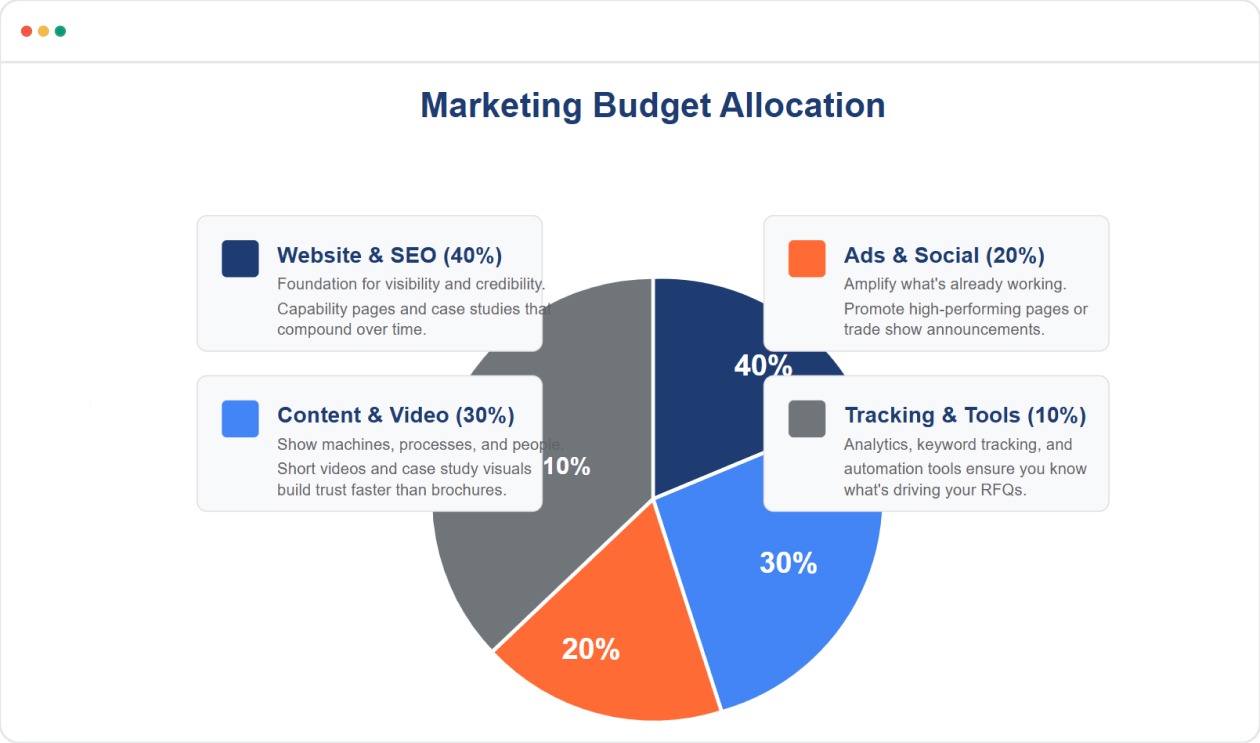Schedule a Call
Get started with your organic growth journey!




In 2025, a precision machining company in Ohio lost a $240,000 contract.
The reason was painfully simple.
The buyer said, “We went with someone we found online last week.”
That’s how industrial digital marketing works today. It rewards visibility across multiple online platforms where buyers now search.
The company owner had never heard of this competitor. They weren't any bigger. They didn't have better equipment. They just showed up first in Google search results when the buyer searched.
A DemandGen report says 80% of B2B buyers now research online before making any sales contact. They're comparing tolerances, certifications, lead times, and capabilities— before picking up the phone.
And while you’re reading this, there’s probably another buyer right now searching for exactly what you offer… but finding someone else.
Here’s what industrial digital marketing success really looks like:
For most US industries, the shift is clear: buyers are no longer relying solely on trade shows, referrals, cold calls, or sales reps.
They now begin their search online, often with a quick Google search. Digital marketing helps industrial and manufacturing companies appear exactly where decisions are made: Google, Industrial Forums, Facebook, sponsored Ads, etc.
It strengthens your online presence, brings in qualified leads, and positions you ahead of competitors still stuck in traditional outreach.
In fact, research shows B2B organizations allocate 8.7% of their total budget to marketing, and US B2B ad spend is expected to hit $19.22 billion by 2025–26.
And that’s exactly why digital marketing matters today: it brings your buyers to you instead of relying on chance.
Remember: Traditional lead generation still has its place, but it doesn’t work the way it used to. Trade shows are seasonal and expensive, and mostly filled with researchers, not buyers. Referrals are drying up as the next generation of procurement managers relies on Google rather than handshakes. And cold calls? They simply go to voicemail if they’re not screened out first.
Digital marketing is an umbrella term. It simply means being found and chosen online by buyers who are already searching for what you make.
To define, it is a strategic practice for promoting the products or services you sell. It uses the internet and digital channels, including websites, social media (LinkedIn, Facebook, YouTube, Instagram), search engines (Google, Yahoo, Bing, Safari), email, and online ads (Google Ads, Facebook/Meta Ads) to reach and connect with customers.
Most manufacturers don’t lose leads due to lack of effort. They lose them due to lack of direction. When you know who you’re targeting, where they are, and what influences their decisions, digital marketing becomes predictable, measurable, and scalable.
Once these principles are in place, the next step is choosing the right digital marketing channels that can consistently reach and influence buyers.
There are two main sides to digital marketing: inbound and outbound.

Outbound is what you already know: trade shows, cold calls, referrals, TV ads, print ads, billboards, or direct emails without subscriptions. That’s you reaching out.
Inbound, on the other hand, is when buyers come to you, through Google searches, your website content, videos, SEO (Search Engine Optimization), paid ads (Search Engine Marketing), or even a LinkedIn post they stumbled upon.
The best industries today don’t choose one over the other. They combine both.
Outbound helps you chase big contracts. Inbound builds a steady, predictable pipeline of qualified RFQs, even while you’re on the shop floor.
Think of digital marketing like your online industrial floor. Each of its channels plays a role.
In short:
In manufacturing, not all channels perform the same way. Some build visibility, some bring instant leads, and others strengthen your credibility.
Here’s how each one contributes, starting with online search visibility.
Be the Manufacturer They Find You First
If your factory isn’t showing up when buyers search for your exact capabilities, they’re finding someone else. Even if your quality, lead times, and certifications are better, they chose your competitor over you.
That’s where SEO helps. Search Engine Optimization (SEO) ensures your website appears in front of them, organically and cost-effectively. It’s how you get found on Google (Safari or even Bing) without paying for every click.
If you answer the keywords your buyers are typing/searching for, you simply show up at the top. Remember, there is always a strategy to be on top.
How to do it: Update your website pages monthly with technical content and case studies to improve rankings consistently.
Focus on:
Buyers rarely scroll past page one; appearing first directly drives more RFQs.
Think of it as: Your digital factory floor, where clarity, structure, and precision help buyers (and Google) understand what you do best.
Instant Visibility for New Products or Markets
Sometimes you need instant visibility to reach buyers in new regions or launch a new service. Relying solely on SEO may cost you these valuable contracts.
Paid channels like Google Ads, LinkedIn Ads, or Facebook/Meta Ads help you reach buyers instantly. However, paid channels are effective only as long as you pay for them. It stops getting you results once you stop paying for it. Therefore, you must have solid plans to work with paid channels.

How to do it: Start small with highly targeted campaigns, monitor clicks, and adjust keywords weekly to maximize ROI. Track where they land once they click.
Focus on:
Paid ads capture buyers who aren’t yet aware of you, preventing high-value lost contracts.
Think of it as: Your fast lane to online visibility while SEO builds long-term results.
Make Your Website Work as Hard as Your Sales Team
Your website is not just a digital brochure. It’s a 24/7 sales floor that educates your buyers and converts interest into leads while your team focuses on production.
Content marketing strategies such as blogs, videos, and capability pages should educate your buyers about your expertise and processes.

How to do it: Build content on solving buyer questions and showing process transparency, not just marketing speak.
Focus on:
Educated buyers are more likely to submit RFQs because they trust your expertise.
Think of it as: Turning your knowledge into buyer confidence.
Keep Buyers Coming Back To You
Not every buyer is ready to order on first contact. A structured email campaign keeps you top-of-mind, so when they’re ready, you’re the first company they call.
How to do it: Use automated sequences for follow-ups and segment lists to ensure each audience type receives relevant content.
Focus on:
Buyers forget vendors if you don’t stay in touch. Always remember to keep them at the back of your mind.
Think of it as: Your digital handshake that keeps relationships warm.
Here’s a ready-to-use email template
Be Where Your Buyers Are
Decision-makers today often look for proof of expertise before contacting manufacturers in the US. Sharing project updates or process videos online can make your brand memorable.
For manufacturers, LinkedIn is your best stage. It’s where engineers, OEMs, and sourcing managers scroll. Some manufacturers are also building their presence on Facebook or YouTube.

How to do it: Post at least once a week, share behind-the-scenes, and respond to comments to show engagement.
Focus on:
Decision-makers often research companies on LinkedIn before filling out RFQs; visibility builds trust.
Think of it as: Showcasing your credibility in the digital marketplace.
Let It Come From Others To Build That Trust
Buyers trust third-party validation more than self-promotion. Positive reviews and trade mentions instantly boost credibility. Earned media builds trust, helping your buyers understand that you are credible and not “scam-y”. This eventually drives RFQs.

How to do it: Encourage reviews after completed orders and actively share press mentions on your website and LinkedIn.
Focus on:
Buyers trust third-party validation more than marketing claims, thereby shortening RFQ decision time.
Think of it as: Word-of-mouth for the digital age.
When done right, all of these digital marketing channels work together to make your manufacturing business easier to find, trust, and choose online.
Not all channels perform the same way, and it’s easy to miss gaps. Use this quick scorecard to see where your factory is strong—and where you might need improvement:
How to use it: Note how often you post, update, or run campaigns in the Frequency column.
When gaps appear, you’ll know exactly which channels need more focus or guidance from a trusted partner.

You don’t need a 10-person marketing department to compete online. You just need the right setup for your size and goals. There are a few ways to get it done effectively:
The right choice depends on your size, goals, and how quickly you want to start generating RFQs.
If you already have someone who understands your products and buyers, upskilling them in SEO and content can go a long way. The challenge is time.
Most manufacturing marketing leads juggle multiple roles —quoting, trade shows, and brochures —leaving little time for consistent online visibility work.
Agencies can help you move fast, especially for website redesigns or paid ads. But they often come with long retainers, slower feedback loops, and a learning curve about your technical products. In niche industries like yours, it can be an expensive experiment before results appear. Plus, if you just need leads, this is a long journey.
This model works best for most manufacturers today. You bring industry knowledge — such as your tolerances, materials, and processes — while specialized partners handle content creation, SEO, and analytics.
AI-powered agents like Gushwork.ai, explicitly built for manufacturing marketing, significantly improve lead generation in 3 months. It helps make your website, product pages, capability pages, case studies, and SEO content in weeks.
These agents can deliver 4 weeks of content in 4 weeks, whereas most teams take 6 months to achieve the same. This helps you generate qualified leads faster and more efficiently.
5 Questions Manufacturers Should Ask Before Doing Digital Marketing
1. Who is my ideal buyer, and where are they searching online?
Understand whether engineers, procurement managers, or OEMs are your audience and which platforms they use.
2. What are my most valuable products, services, or capabilities to promote?
Focus your digital marketing on channels that deliver the highest ROI.
3. Do I have the right internal resources, or should I partner with experts?
Consider time, expertise, and bandwidth before deciding on in-house, agency, or hybrid models.
4. How will I measure success?
Define Key Performance Indicators, such as RFQs, website landers (traffic), leads, or quote conversions, not just clicks.
5. What gaps exist in my current online presence that I need to fix first?
Identify missing capability pages, outdated case studies, poor SEO, or unclear CTAs before investing in new campaigns.
For most US manufacturers, allocating around 5-7% of annual revenue to digital marketing offers a strong balance between investment and return.
Within that budget, we recommend that the digital-marketing portion be structured roughly as:

A mid-sized manufacturer can usually invest around $5,000/month in digital marketing and start seeing 10–20 qualified RFQs per month within six months.
For smaller manufacturers, allocating that much is often challenging because they’re constantly balancing orders, equipment, and staff. That’s where AI-assisted platforms or hybrid partners come in — for $500–$1,000/month.
Even small manufacturers can achieve similar outcomes without adding headcount, enabling them to compete for visibility and leads alongside larger players.
The key isn’t how much you spend. It’s how consistently you execute. A steady flow of monthly content, keyword tracking, and visible proof of work will outperform big ad bursts every time.
What matters more than budget is consistency. Posting monthly case studies and tracking keyword gains beats random ad bursts.
For manufacturers, digital marketing without a clear plan can waste months on content or ads that don’t generate results. A structured roadmap ensures that every action—from improving visibility to building credibility—contributes to qualified RFQs.
Many US manufacturers follow this step-by-step approach to move from “invisible online” to a consistent flow of high-quality leads.
You don’t need expensive software to make this plan work. Use the following tools to keep you consistent.
Every manufacturer that scaled visibility fast had one thing in common. They tracked, automated, and optimized from day one. Here’s how you can too.
Without tracking what drives leads, you might spend money on tactics that don’t generate RFQs. Data tells you what’s working and what to fix. Every click, visit, or form submission tells a story. Tracking these helps refine your strategy.

How to do it: Set clear goals (form fills, downloads) and review dashboards weekly to optimize campaigns and content.
Focus on:
Without tracking, you won’t know which channels are generating RFQs, where your buyers are landing, and what they like the most.
Many manufacturers struggle because of common pitfalls that they share with us, often on sales calls. Avoiding these mistakes early ensures consistent execution, smarter decisions, and steady growth in digital marketing results.
Tip: Combine the right tools with steady execution and real proof —that’s how manufacturers actually generate qualified RFQs.
In today’s manufacturing world, visibility decides who gets the RFQ. Buyers don’t wait for calls or trade shows; they search, compare, and shortlist online.
That’s where digital marketing wins. A clear website, consistent SEO practices, strategic paid channels, and proof-driven content make your industry in the US show up first and get chosen faster. You don’t need a big budget or team. You just need the right setup and rhythm.
Every page, post, and case study compounds your reach. Start small, stay consistent, and within months, you’ll see your website working harder than any sales rep ever could.
Remember, the buyer hasn’t changed what they want (precision, reliability, speed), but they have changed how they find it. And in 2025, that search starts online.
1. Does industrial digital marketing actually work?
Yes! Across 100+ small and mid-sized US manufacturers, those who stay active online with simple steps like updating their website, sharing project updates, running a few Google or Meta ads, or sending monthly emails now receive 15–20 qualified RFQs each month.
2. Why isn’t digital marketing working for my manufacturing business?
Most manufacturers give up too soon or post generic GPT content. Results come when your website clearly explains your capabilities, materials, tolerances, and the industries you serve. Buyers don’t search for “services”. They search for specifics like “CNC aluminum machining aerospace parts.”
3. What if my buyers are older and not tech-savvy?
Even older decision-makers research online first, often on desktop, not smartphones. They may not browse social media, but they do Google suppliers, check certifications, and read websites before replying to an RFQ email.
4. How do I compete if my competitors already have manufacturing relationships?
Relationships matter, but new projects, capacity gaps, and reshoring trends open doors. Your online presence ensures you’re seen when those opportunities appear. Even if they don’t switch suppliers immediately, they remember the company they found online when the next need arises.
5. Is online lead generation worth it for small manufacturers with thin margins?
Yes, because it compounds. An initial investment in SEO and content continues to generate RFQs for months or even years. It’s far more cost-effective than paid ads, seasonal trade shows, or cold calls once the foundation is built.
6. What’s the best way to start digital marketing for industries if I have limited time or people?
Start small. One optimized capability page + one case study + one LinkedIn post per week. Then partner with a lead-generation company specializing in manufacturing SEO to scale faster while you focus on production.
.svg)